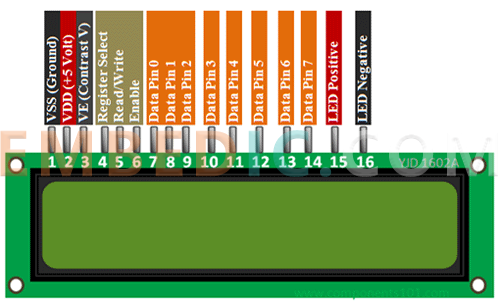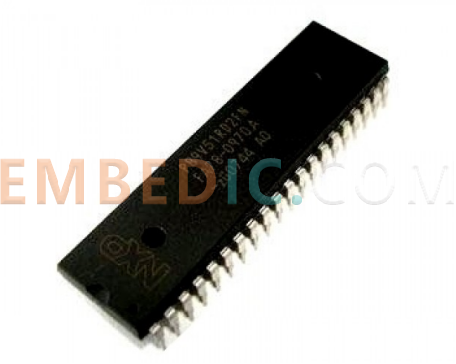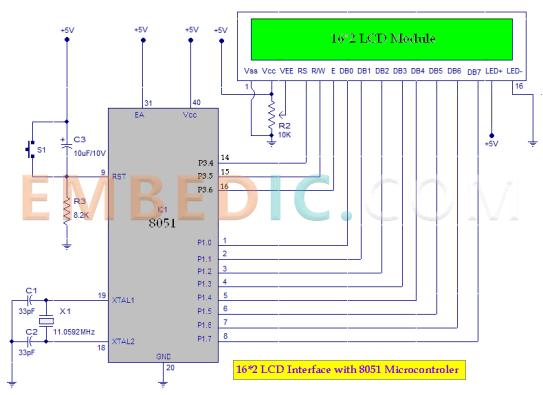An LCD (Liquid Crystal Display) is a type of flat-panel display technology commonly used in electronic devices such as computers, digital watches, DVD players, and more. Unlike older display technologies like CRTs (Cathode Ray Tubes), which are bulky and consume more power, LCDs offer a compact, lightweight, and energy-efficient solution for displaying information.
The working principle of an LCD involves the use of liquid crystals sandwiched between two layers of transparent electrodes. These liquid crystals can manipulate light passing through them when an electric current is applied. By controlling the arrangement of these liquid crystals, the display can produce images and text.
In the case of a 16x2 alphanumeric LCD, it consists of a grid of 16 characters per line and 2 lines, allowing it to display a total of 32 characters. Each character is displayed using a 5x7 pixel matrix. The LCD module contains two registers: a command register and a data register. The command register is used to send instructions to the LCD, such as initializing it, clearing the screen, setting the cursor position, and controlling the display. The data register stores the ASCII values of the characters to be displayed on the screen.
Overall, LCDs offer advantages such as cost-effectiveness, programmability, and the ability to display custom characters and graphics, making them versatile and widely used in various electronic devices and circuits.

Pin Configuration
|
Pin No |
Pin Name |
Description |
|
1 |
Vss (Ground) |
Ground pin connected to system ground |
|
2 |
Vdd (+5 Volt) |
Powers the LCD with +5V (4.7V – 5.3V) |
|
3 |
VE (Contrast V) |
Decides the contrast level of display. Grounded to get maximum contrast. |
|
4 |
Register Select |
Connected to Microcontroller to shift between command/data register |
|
5 |
Read/Write |
Used to read or write data. Normally grounded to write data to LCD |
|
6 |
Enable |
Connected to Microcontroller Pin and toggled between 1 and 0 for data acknowledgement |
|
7 |
Data Pin 0 |
Data pins 0 to 7 form an 8-bit data line. They can be connected to the Microcontroller to send 8-bit data. These LCDs can also operate in 4-bit mode; in such case, Data pins 4, 5, 6, and 7 will be left free. |
|
8 |
Data Pin 1 |
|
|
9 |
Data Pin 2 |
|
|
10 |
Data Pin 3 |
|
|
11 |
Data Pin 4 |
|
|
12 |
Data Pin 5 |
|
|
13 |
Data Pin 6 |
|
|
14 |
Data Pin 7 |
|
|
15 |
LED Positive |
Backlight LED positive terminal |
|
16 |
LED Negative |
Backlight LED negative terminal |
The 8051 microcontroller, a pioneering creation of Intel Corporation in 1980, represents a landmark in the evolution of embedded computing. This versatile chip amalgamates the functionality of a microprocessor with a rich array of onboard peripherals, including ROM, RAM, I/O ports, serial interfaces, timers, interrupts, and clock circuits. Its compact yet comprehensive design renders it indispensable across a diverse spectrum of applications, from household appliances like washing machines to intricate industrial and automotive systems.

Originally developed utilizing N-type Metal-Oxide-Semiconductor (NMOS) technology, subsequent iterations, such as the 80C51 series, transitioned to more efficient Complementary Metal-Oxide-Semiconductor (CMOS) technology. This shift not only improved performance but also enhanced power efficiency, making the 8051 microcontroller well-suited for battery-powered applications.
The classification of microcontrollers based on their bit processing capability, with the 8051 typically being designated as an 8-bit microcontroller, underscores its ability to manipulate data in byte-sized chunks. While the 8051 blazed a trail in its time, modern iterations such as AVR and PIC microcontrollers have since emerged, offering compact form factors, enhanced computational capabilities, and cost-effectiveness.
In essence, the 8051 microcontroller symbolizes the fusion of computational prowess and integrated circuitry, catalyzing the proliferation of embedded systems that permeate every facet of contemporary life, from smart appliances to industrial automation.

The circuit diagram illustrates the interfacing of an LCD (Liquid Crystal Display) with an 8051 microcontroller. By connecting the LCD to the microcontroller, the aim is to enable the microcontroller to control and display information on the LCD screen. This facilitates the creation of user interfaces and visual feedback systems in embedded applications.
The 8051 microcontroller communicates with the LCD through a set of data pins (D0-D7) connected to Port 2 (P2_0 – P2_7) of the microcontroller. Additionally, control pins RS (Register Select), RW (Read/Write), and E (Enable) are connected to pins 12, 13, and 14 respectively (corresponding to pins 2, 3, and 4 of Port 3) of the microcontroller.
The power and ground pins (VDD, VSS) of the LCD are connected to the supply voltage (5V) and ground respectively, ensuring proper operation. Furthermore, the backlight supply pins (PIN 15) and ground pins (PIN 16) are connected to voltage and ground respectively, to provide illumination to the display.
Pin 3 (V0) of the LCD, responsible for contrast adjustment, is connected to a variable resistor of 10k ohms. By varying the resistance, the voltage applied to Pin 3 can be adjusted, thereby controlling the contrast of the LCD display. This allows for optimal readability under different lighting conditions.
In essence, the circuit facilitates bidirectional communication between the 8051 microcontroller and the LCD, enabling the microcontroller to send commands and data to the LCD for display, while also allowing the microcontroller to receive feedback from the LCD if necessary. This integration enhances the functionality and user interaction capabilities of embedded systems employing the 8051 microcontroller.
Interfacing an LCD with an 8051 microcontroller necessitates a systematic approach to sending commands and data to the display unit. The programming logic involves distinct functions for sending data, strings, commands, and initializing the LCD. These functions are pivotal in facilitating bidirectional communication between the microcontroller and the LCD, enabling seamless display control.
// Function to send data to the LCD
void dat(unsigned char b)
{
lcd_data = b;
rs = 1; // Set RS to 1 to select the data register
rw = 0; // Set RW to 0 for write operation
en = 1; // Generate high-to-low pulse at EN pin
lcd_delay(); // Delay for proper timing
en = 0;
}
// Function to send a string to the LCD
void show(unsigned char *s)
{
while (*s) {
dat(*s++); // Send each character of the string
}
}
// Function to send a command to the LCD
void cmd(unsigned char a)
{
lcd_data = a;
rs = 0; // Set RS to 0 to select the command register
rw = 0; // Set RW to 0 for write operation
en = 1; // Generate high-to-low pulse at EN pin
lcd_delay(); // Delay for proper timing
en = 0;
}
// Function to initialize the LCD
void lcd_init()
{
cmd(0x38); // Set the display to 2 lines, 5x8 matrix
cmd(0x0e); // Turn on display, cursor blinking
cmd(0x01); // Clear display
cmd(0x06); // Set cursor to increment mode
cmd(0x0c); // Turn off cursor
cmd(0x80); // Set cursor to the beginning of the first line
}
These functions encapsulate the essential operations required for interfacing an LCD with an 8051 microcontroller, enabling the display of text, symbols, and custom messages with precise control and efficiency.
Why interface an LCD with an 8051 Microcontroller?
Interfacing an LCD with an 8051 microcontroller provides a convenient way to display information or status messages in embedded systems, such as electronic appliances, industrial automation systems, and consumer electronics. It enhances the user interface and facilitates real-time feedback or monitoring.
What types of LCD Modules are compatible with 8051 Microcontrollers?
Most alphanumeric LCD modules with HD44780 or compatible controllers are compatible with 8051 microcontrollers. These modules come in various sizes (e.g., 16x2, 20x4), and they typically have a parallel interface for communication with the microcontroller.
What are the Different Types of LCDs?
LCDs come in various types, including Twisted Nematic (TN), In-Plane Switching (IPS), Vertical Alignment (VA), and Organic Light-Emitting Diode (OLED) displays. Each type has its own characteristics, such as viewing angles, response times, and color reproduction.
How are LCDs Interfaced with Microcontrollers or Other Devices?
LCDs are typically interfaced with microcontrollers or other devices using parallel or serial communication interfaces. Control signals and data lines are connected between the LCD and the controlling device to send commands and display content.
What are the Advantages of LCDs?
LCDs offer several advantages, including thin and lightweight form factors, low power consumption, high resolution, and compatibility with various electronic devices. They also provide good image quality and can display content in both monochrome and color.
Manufacturer: Analog Devices
IC DSP 32/40BIT 400MHZ 324CSBGA
Product Categories: DSP
Lifecycle:
RoHS:
Manufacturer: Texas Instruments
IC DSP FIX/FLOAT POINT 176HLQFP
Product Categories: DSP
Lifecycle:
RoHS:
Manufacturer: Texas Instruments
IC DGTL MEDIA PROCESSR 684FCBGA
Product Categories: DSP
Lifecycle:
RoHS:
Manufacturer: Microchip
IC MCU 16BIT 16KB FLASH 28SOIC
Product Categories: 16bit MCU
Lifecycle:
RoHS:
Looking forward to your comment
Comment